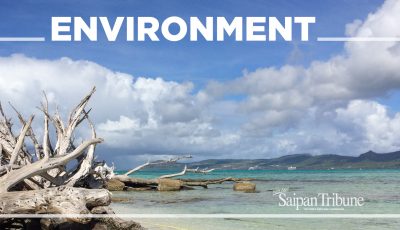Secondary roads leading to popular beaches being cleared
Mayor urges tour operators to encourage clients to slow down when driving
Mayor David M. Apatang’s beautification project is now focusing on road clearing for degraded pathways leading to popular tourist sites and beaches.
Apatang said that Tank Beach and Marine Beach have been cleared of vegetation and potholes have been covered.
“We are in collaboration with Marianas Visitors Authority to do some road clearing to popular beaches that tourists have been going to recently because we not only want them but also our residents who visit these beaches to be safe and less pressured when driving on these pathways,” Apatang said.
Joann Aquino, field operations director for the Saipan Mayor’s Office, said they have been working on the Forbidden Island Road since last week.
Forbidden Island is a popular tourist site in Kagman, with more than 20 tourist-rented vehicles usually going there everyday. However, some tourists get stuck in the deep potholes, causing problems not only for tourists but residents as well.
“We have been working on that since last week. We have widened the area because it is a little small for cars to go through. We’re doing road clearing, vegetation from trees and bushes are being cleared, and covering a lot of the huge holes there,” Aquino said.
“We are going to do Obyan and Lao Lao Beach as well. The road to Lao Lao Beach is very bad and vegetation growth is already going into the roadways. So we’re clearing these areas,” she added.
So far for the beautification project, more than 25 loads of trash the size of a dump truck has been recovered from villages and typhoon debris as well since February of this year.
‘Tourists need to slow down’
Apatang said his staff have encountered some problems during the clearing of the roads, particularly tourists who drive fast.
“I want to encourage tour operators to inform their clients that they need to slow down when they are driving. Tourists who drive through these areas are sometimes driving way too fast. This is not only a safety problem but it degrades the cars and it is also too dangerous. Tour operators need to be aware and be more responsible in informing tourists of the dangers in driving on these roads,” he said.
According to Apatang, he has encountered tourists driving close to 40 miles on a dirt road.
“That is not safe. They have to be more careful,” he said.
E-waste removal
Apatang said he is still working on getting electronic wastes out from villages.
Among the 25 loads of trash that his office has cleared, majority of the electronic waste are from Chalan Kanoa, where some of the staff are still cleaning and removing trash until now.
Apatang said that he has met with several people regarding e-waste.
“The Environmental Protection Agency needs to do some environmental survey before we can do anything about e-waste removal,” he said.
Apatang earlier told Saipan Tribune that he is working with a trash collection company to remove e-waste.
Electronic scrap components, such as CRTs, may contain contaminants such as lead, cadmium, beryllium, or brominated flame retardants. Disposal of e-waste may involve significant risk to workers and communities and great care must be taken to avoid unsafe exposure in recycling operations and leaking of materials such as heavy metals from landfills and incinerator ashes.


























